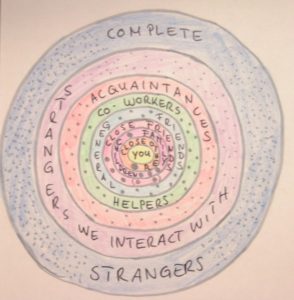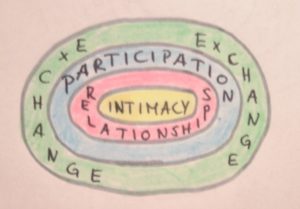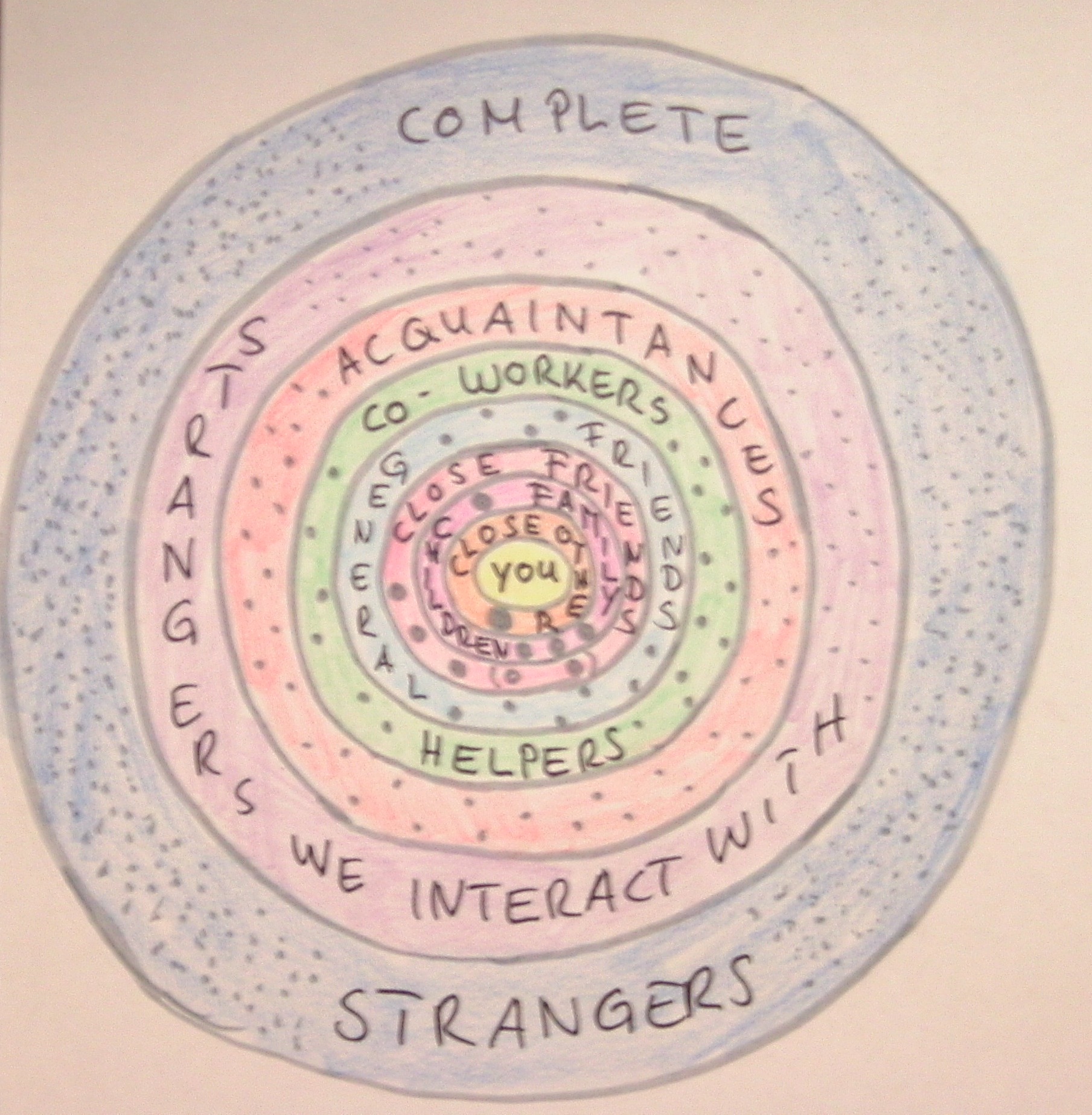All relationships are not the same. It is a myth that we could (or should!) treat people in our life equally and not everyone should have free access to us and our resources. We don’t have enough time, energy, attention, money etc to invest into every relationship in the same way.
The circles of relationships can help us to get a better idea how we relate to people, what our interactions should look like and where to invest our resources with priority.
Ideally it would look something like this:

circles of relationships
We are at the core. The closest and most intimate connection we have is with ourselves. With DID that automatically includes our system. It is also called the God Spot, because it is where we practice our spirituality (or philosophy). If there is anything else in that spot in your life, it will cause problems. Neither your partner nor your children should have this place. That is not a sign of love, it is emotionally abusive.
Next comes our closest relationship. That is usually a partner, in some cases a parent or a very close friend or sibling. There is only one most important person in our life. If we are married and this is not our spouse we might be in trouble.
After that comes our own children, family, and close friends.
Some people believe that they should have a great number of close friends, but realistically we only have the resources to invest into 2-5 close friendships. They are our inner circle.
Then there are general friends, co-workers, helpers, acquaintances, strangers we interact with regularly and finally complete strangers. The more distant the circle the more people fit into it.
Exercise: Try to remember all the people you interacted with yesterday and sort them into a circle.
To protect ourselves and our relationships it is important to invest our resources according to the priorities shown by the circles. I am always willing to take the time to listen to one of my parts. I am often willing to listen to close friends. But I am greedy about my time and attention when it comes to complete strangers. They get what is left after I took care of what is important to me, and only if I feel like it. If you find a major imbalance between the way you invest your resources and your relationship circles, it might be time to make some changes and set your boundaries differently.
The people we connect with have different lives and their circles look different from ours. It might be important to communicate about this. If someone you would place as close friend only thinks of you on the level of co-worker, it tells you what you can expect from this relationship. It is always only as close as the more distant person defines it. It might be painful, but we have to accept that. If someone feels closer to you than you do to them, it is time to communicate a boundary. Don’t be afraid to friend-zone anyone. Today you decide what you want.
With cPTSD you might have no sense of what would be appropriate interactions with people because it has always been normal that anyone could just approach you; there were no circles. I would recommend working with the Circles App until you are more secure. It was created for autism, but it is exactly the kind of tool that could support you.
The model I shared above is an ideal for a healthy person. It usually differs a lot from the reality of someone who is living with cPTSD or DID. We often had to cut contact with (parts of) our family, can’t cope with an intimate relationship, can’t have children and our symptoms make it difficult to build close friendships. Add disability, social anxiety and agoraphobia and there is little left of the original circles. If that is you, it might help to work with this version of circles:

Intimacy includes you, your system, a significant other if there is one and the God spot.
Relationships means anyone you are in a closer relationship with, that could be friends or family
Participation stands for people you meet in a specific group or setting. That could include co-workers, people from your yoga class, church, football team or therapy group.
Exchange happens with strangers you interact with, like a cashier, hairdresser, woman in the park with a cute dog, person on a train etc.
If there is a painful lack in one area we can reduce the suffering it causes by investing more into other circles. It is not the same and never will be, but it is still a relief from loneliness. It means that solid Relationships can help with out sorrow over not having a partner. A lack of friends can be eased by investing into Participation and positive Exchanges. It is always a good idea to invest into a rich relationship with yourself and the God Spot.
It is important to grieve what we can’t have and accept it to avoid unnecessary suffering. Then we can focus on investing into other circles to improve our quality of life. Over time strangers might become friends.


This is very helpful to me! Especially the 2nd version. It helped me to see I’m really doing ok in these areas. Having it drawn like this , in circles , I could see and understand .
Thanks for this model, this is a helpful perspective for thinking about relationships. I’m currently working on improving friendships and I’d be interested to read more on relationships, e.g.
– among two or more people w CPTSD: how to prevent/manage a trauma bond to form? (In my experience due to oversharing in the early stages of recovery it is something that easily occurs)
– how to manage asynchronous healing timelines?
– how to stay overall regulated while being an extrovert person (I’m getting the impression that most people retreat in a small-ish social circle while they heal)?
– How to support each other’s healing (most advice on boundaries doesn’t account for solidarity, which in my opionen can and probably should be a goal after taking care of yourself)?
– how can we make relational healing experiences with non-professionals and enhance frequency and quality of those experiences?
This isn’t a comprehensive list in any way, just a few thoughts I’m currently working with.
I’d gladly read your take on this. I’d appreciate a lot if you can point me to some resources (I already checked out all books in your recommendations section).
That is about a books worth of good questions!
right now we are not planning to cover the topic soon, since we have to learn a lot ourselves.
I don’t know a book that covers the topics either. 🙁
The best thing would be to work with a therapist, maybe a systemic trauma therapist, to figure things out as you go.
Sadly, I can’t answer all the questions myself.
Thank you for your fast response, I appreciate it.
I’m already working with a therapist, but I’d like some guidance while I go. Reading through peer online resources, I’m getting the impression that most people seem to limit their social interactions drastically (partly involuntarily due to stigma, partly to manage stress better, partly because new situations like going inpatient influences new and old relationships). Also, a lot of people don’t seem to have a solid social foundation to begin with as they enter treatment/develop trauma awareness. I’ve had my trauma fallout, but I’m not there any more, so I need a different approach.
I’d like to keep my social environment, minimize time and energy I used to lose in one-sided/partly toxic relationships and learn to introduce anything new I learn about my past into those relationships.
I have asked around but nothing useful came up.
So it seems best to look into books on healthy relationships for healthy people and then adapt and modify where needed. It is what we mostly do when nothing that specialized is available.
In case you find a book that addresses what you need, please come back and tell me about it. I want to read it too.